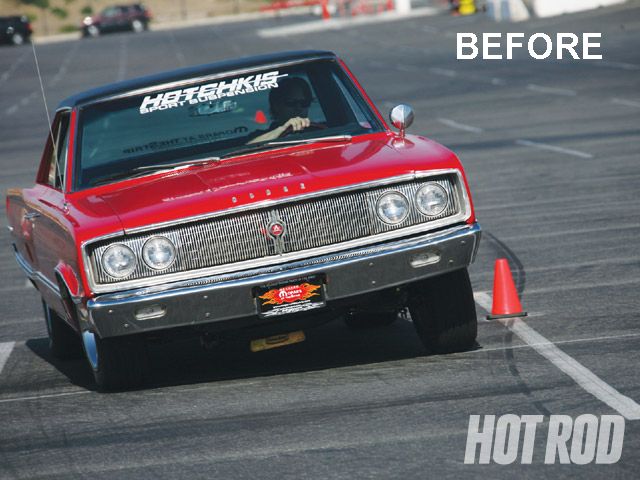
OK, we'll admit it. As much as it's cool to see over-the-top cars with IndyCar suspension and Pro Stock power, after a while it just gets repetitive. Where are the bolt-on cars? What about guys who actually have real blue-collar jobs and drive their muscle cars on a regular basis? We know you're out there and actually realize 99 percent of you fit into that category, so here's a story for you. Instead of displaying the latest million-dollar suspension system, we're going to take a big boat of a car and add simple bolt-on suspension parts to it, one at a time, testing along the way to see how effective each part is in improving handling.
We called on the good folks at Hotchkis Suspension to help us out, and they even provided the car, a '67 Dodge Coronet. It was actually already equipped with all of Hotchkis' new B-Body Mopar suspension parts, having been built during the Mopars at the Strip show in Vegas by Steve Strope of Pure Vision. This is the show's giveaway car. Since it was already set up, we went backward with the parts installation-uninstalling things one part at a time until the car was stock. Hotchkis subframe connectors had been installed, and we didn't remove them for testing. (Hotchkis also has a complete suspension for E-Body Mopars.)
The Hotchkis crew met us in the parking lot of California Speedway in Fontana, where we set up a 600-foot slalom with cones spaced 100 feet apart. A slalom is the most accurate test of a car's handling, since it negates the effect of horsepower (which would really help on a full road course) and measures how quick the car is through a series of corners. We installed parts in the order that the typical hot rodder would, starting with wheels and tires, then progressing to the easier and more budget-friendly parts before bolting on the more hard-core stuff. We did it all in one eight-hour day, and company owner John Hotchkis had his brother, Mark, do the driving. Mark raced Indy Lights cars in the '90s and does a ton of SCCA and vintage Porsche racing, so he was more than qualified to guide the Coronet through the slalom.
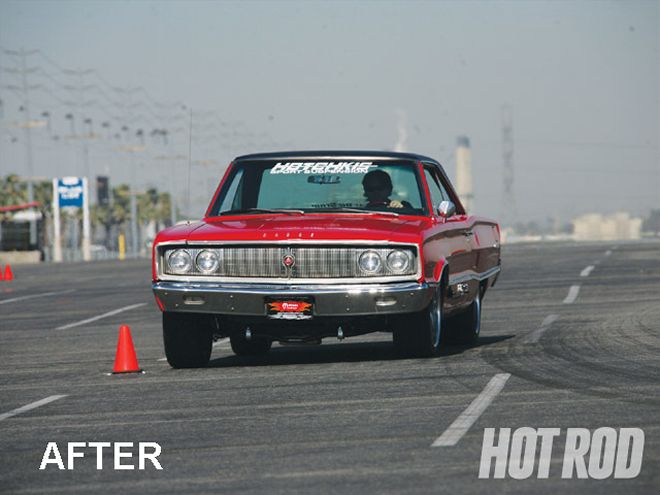
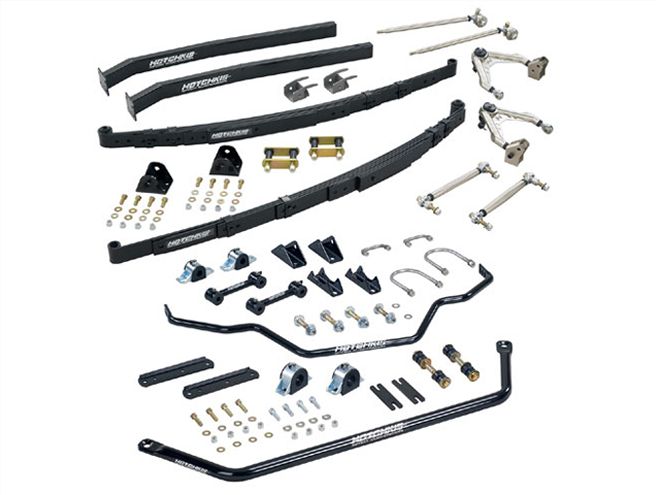 Here's the complete Hotchkis TVS system for the B-Body Mopar, not including the optional shocks.
Here's the complete Hotchkis TVS system for the B-Body Mopar, not including the optional shocks.
Baseline
As delivered, the Coronet had Rallye wheels with BFGoodrich Radial T/A tires 215/70R15 front and 275/60R15 rear-very common on the average street car. It didn't even have a front sway bar. As you can imagine, it was a boat, cornering on the door handles and forcing Mark to really work the wheel to keep it from sliding out of control. It went through the slalom in 8.63 seconds, which translates to 47.40 mph.
Result: 47.40 mph
Same as: '06 Hummer H1
Step 1--Wheels And Tires
The most logical first things to change are the wheels and tires, or more specifically, the tires. Often, performance tires are the single biggest handling improvement you can make to a car, especially an old muscle car. We threw on a much stickier set of 245/45-18 (front) and 255/50-18 (rear) Pirelli PZero Rosso tires (sourced from The Tire Rack) mounted to Bonspeed RodR billet wheels (18x8 with 4.5 inches of backspacing on all four corners) and ran the car again. It picked up nearly half a second and more than 2 mph, but the suspension was still rolling over like a rowboat in a tidal wave.
Price: $2,500 (wheels) and $1,200 (tires)
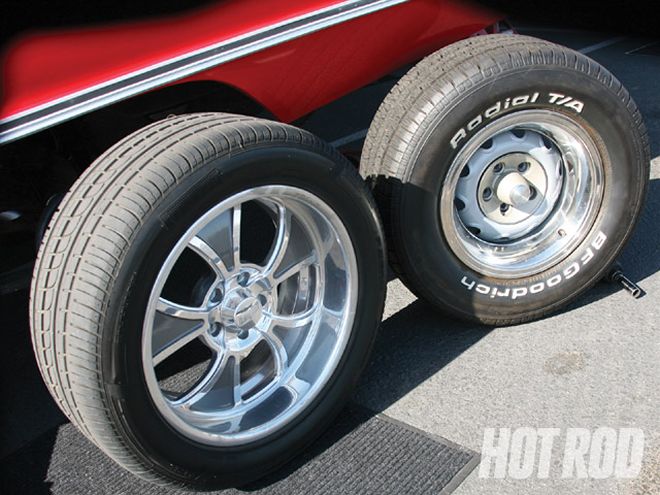 Hasn't everyone had a set of BFGoodrich Radial T/As at some point? While a good tire, the Pirelli PZero Rossos were much stickier. We almost wish they had raised white letters, though.
Hasn't everyone had a set of BFGoodrich Radial T/As at some point? While a good tire, the Pirelli PZero Rossos were much stickier. We almost wish they had raised white letters, though.
Result: 49.65 mph
Same as: '04 Dodge Sprinter 10-passenger van
Step 2--Shocks
After wheels and tires, shocks are the easiest things to change, and choosing the right shocks (with the right settings if they're adjustable) can make a big difference in ride quality and transient handling. The HPS-1000 shocks we installed come as part of Hotchkis' complete kit, or you can get them separately. The improvement in slalom speed shocked us (sorry), picking up more than 3 mph.
Price: $413.60
Result: 52.92 mph
Same as: '00 Chevy Silverado 2500 (two-wheel drive)
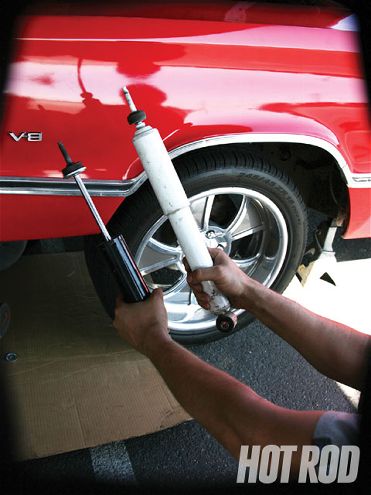 The Hotchkis shocks made a much bigger difference than we expected. That's because they made it easier to stabilize the car in the transitions between the cones. The shocks are tuned with the spring rates and vehicle weight in mind specifically for Mopar B- and E-Body cars.
The Hotchkis shocks made a much bigger difference than we expected. That's because they made it easier to stabilize the car in the transitions between the cones. The shocks are tuned with the spring rates and vehicle weight in mind specifically for Mopar B- and E-Body cars.
Step 3--Front And Rear Antiroll Bars
Antiroll bars essentially tie together the right and left sides of the suspension to limit body roll and make a dramatic difference in handling. But you can go too big with bars and actually lift the inside front tire or throw the car out of balance. The Hotchkis TVS B-Body kit uses a 13/8-inch tubular diameter front antiroll bar and a 1-inch tubular bar in the rear. We knew this would make a big difference since the car didn't have a stock antiroll bar at all, and man, did it.
Price: $660.95
Result: 56.43 mph
Same as: '01 Chevy Silverado 1500 (two-wheel drive)
Step 4--Torsion Bars, Leaf Springs, Adjustable Strut Rods
Stiffer springs make a car handle flatter by requiring more force to compress, therefore changing springs will nearly always improve cornering. As with sway bars, you can go too stiff, however, especially when the road is bumpy or ride quality is a major consideration. The stiffer the spring, the harsher (usually) the ride. Mopars eschew the conventional coil spring front suspension in favor of torsion bars, so Hotchkis swapped the front torsion bars for bigger ones (0.960 versus 0.890, effectively stiffening the rate) and the rear leaf springs for stiffer leaves with 157 lb/in rate (compared with 100 lb/in stock). The rear springs feature high-durometer polyurethane and rubber bushings and lowered the car an inch. The handy thing about torsion bars is that they are adjustable for ride height. Finally, Hotchkis adjustable strut rods were installed to positively locate the lower control arms, which improves handling and steering response.
Price: Torsion bars $299.95
Leaf springs $550.95
Adjustable strut rods $330.95
Result: 58.36 mph
Same as: '02 Isuzu Axiom X5
Step 5--Adjustable A-Arms
The last step, replacing the stock upper control arms with Hotchkis' tubular arms, was the most involved, but the crew got it done in about an hour-and that included taking a water break. The Hotchkis arms correct excessive caster gain and build a better negative camber curve, greatly improving the tires' contact pattern with the road and, therefore, handling.
Price: $770.95
Result: 61.06 mph
Same as: '01 Honda Accord
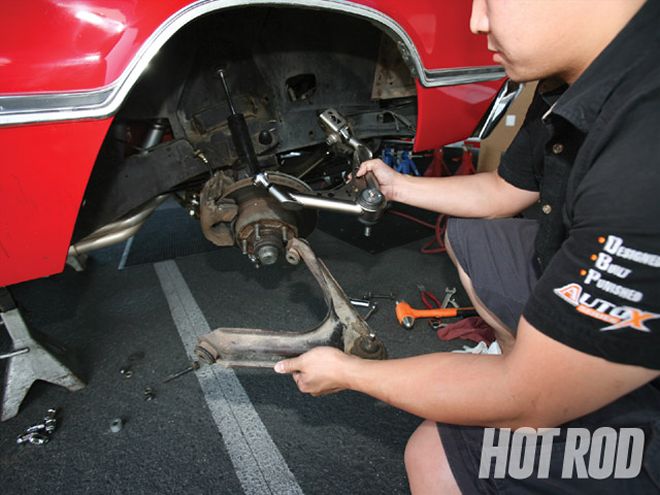 The tubular upper control arms correct excessive caster gain and create a better negative camber curve, both of which are good for sticking the car to the road. They use the stock K-member and have a bracket that relocates the front mounting point so you don't have to drill any new holes. They come with fully articulating rod ends and quality ball joints.
The tubular upper control arms correct excessive caster gain and create a better negative camber curve, both of which are good for sticking the car to the road. They use the stock K-member and have a bracket that relocates the front mounting point so you don't have to drill any new holes. They come with fully articulating rod ends and quality ball joints.
Summary
For less than $3,500 (not counting the tires and wheels) we transformed this Coronet from a wallowing pig into a respectably handling muscle car. It won't take on Corvettes (it's still a big car after all), but it won't embarrass itself in an autocross, either. And since a lot of us don't have a ton of money these days, you don't have to pony up for the whole nut at once. Piece it together like we did here, and these are the results you can expect.
Slot Cars
The idea for this story came about when the author and John Hotchkis were talking at the '08 SEMA show about the new Mopar suspension kits from Hotchkis. We had worked together on a part-by-part story centered around a '68 Chevelle way back in the Apr. '94 issue and thought the brand-new Mopar parts deserved a similar story. So just in case you're having a bout of deja vu...